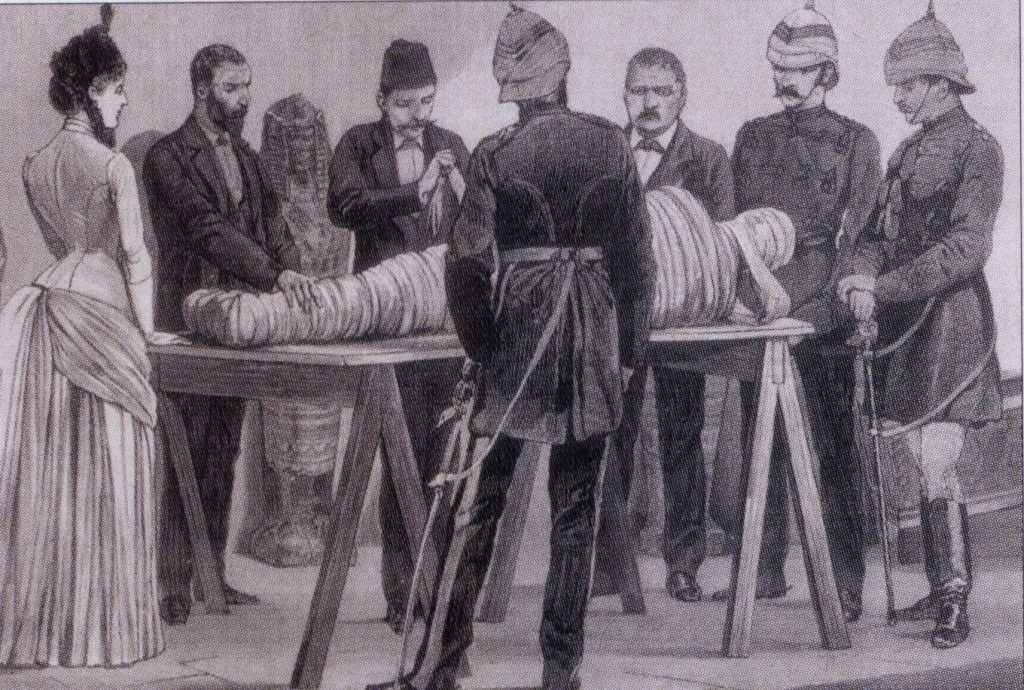How Many Facts Do You Really Remember?
For a lot of people, history was their least favorite subject in school. That’s mostly because stuffy textbook writers leave out all the good bits. So let’s look at some crazy facts that were left out of your school textbook. (Spoiler: people are crazy.)
15. Victorians Held “Mummy Parties”, Which Probably Aren’t What You Think
In early 19th century England, ancient Egypt was all the rage. Victorians couldn’t get enough of the Egyptians. Enter Thomas Pettigrew, a surgeon turned antiquarian. Harnessing the Victorians' love of Egypt, science, and the macabre, Pettigrew hosted a party where he unwrapped a mummy in front of a live audience “for science!” He was trying to use craniometry to prove Egyptians were Caucasian and not of African origin.
14. Rasputin Was a Real Life Video Game Boss
Grigory Rasputin was a “holy man” who was loved by the Romanov family of imperial Russia. Initially acting as a healer for Alexi, the son of the Tsar, Rasputin’s influence over the family, and therefore Russia, expanded up until December of 1916, when a group of noblemen decided he needed to go. While the truth of what happened to Rasputin is highly debated, the most common story is as follows: First, the noblemen gifted him cakes doused with cyanide. When that didn’t work, they gave him three glasses of poisoned wine, which also did nothing. Getting fed up with how poorly things went, they then shot him in the chest. Rasputin then attacked his would-be assassins, who shot him two more times in the struggle and dumped him in the river, where he eventually drowned. Or so the story goes.
 Unknown authorUnknown author on Wikimedia
Unknown authorUnknown author on Wikimedia
13. Teddy Roosevelt Was a Legend
When it comes to presidents, all pale in comparison to the epic Theodore Roosevelt. To read Roosevelt’s life story is to read a series of increasing legendary events. Like when Mike Finnegan stole Teddy’s boat, and Teddy hunted him down in the Dakota Badlands, took the boat back and personally handed Finnegan and his gang over to the cops. Or when Roosevelt led the Rough Riders, America’s first voluntary cavalry, in the battle for San Juan Hill. Roosevelt took anyone who was crazy enough to join him to Cuba, and proceeded to defeat many people. As president, he founded the national park department and built the panama canal. However, the most legendary event of all was the day Roosevelt was campaigning for reelection in Milwaukee. An assassin shot Teddy in the chest. Luckily, Teddy shrugged it off and then proceeded to give his 90 minute speech, opening with the most insane line ever: “Friends, I shall ask you to be as quiet as possible. I don’t know whether you fully understand that I have just been shot.” He then unbuttoned his vest, showing the crowd his stained shirt. Only after finishing his speech did he agree to be taken to the hospital.
 Pach Brothers (photography studio) on Wikimedia
Pach Brothers (photography studio) on Wikimedia
12. Lincoln Once Convinced Some Children To Almost Burn Down a Hotel
Before he was president, Abraham Lincoln was a lawyer. There was a courthouse in Monticello, Illinois where Abe would often argue cases. As such, he was a frequent visitor to the nearby Tenbrook Hotel. What most people don’t know about Honest Abe is that he was a bit of a practical jokester. One evening, Lincoln was sitting in the hotel lobby when he spotted some children playing with an inflated pig’s bladder. He told the children they should try to heat the bladder up in the fireplace. When they did, it exploded, shooting hot coals all over the room. Lincoln hopped up to brush the coals back into the fireplace, but his broom caught fire and he barely managed to keep the whole building from burning down. Try not to think about that the next time you look at Abe’s face on a penny.
 Alexander Gardner on Wikimedia
Alexander Gardner on Wikimedia
11. The Man Who Invented Pringles Was Super Proud of His Accomplishment
Have you ever made something that you were so proud of you want to be buried with it? Fredric Baur did. He’s the man who invented the Pringles can. When he passed, he requested his ashes be buried in a can of Pringles. So on the way to the funeral, his oldest son stopped at a Walgreens, grabbed a can of original Pringles, dumped the chips, and packed their father away. This gives new meaning to the phrase “Once you pop, you can't stop.”
10. Aldous Huxley’s Last Wish
While you're probably most familiar with Huxley’s 1931 novel, Brave New World, the man himself was most familiar with LSD. In the 1950s, Huxley found himself at the forefront of the psychedelic culture where he experimented with Mescaline and LSD, as he documented in his book, The Doors of Perception. So when his number was up, Huxley wanted to go out as he lived, full of psychedelics administered by his wife. He passed later that day.
 John Collier (1850-1934). on Wikimedia
John Collier (1850-1934). on Wikimedia
9. London’s “Great Stink” of 1858
For centuries, the Thames river was the dumping ground for all of London’s waste. Though people realized that polluting the city’s most vital source of water was probably a bad idea, when it came time to come up with a solution, they were always met with debilitating indecision and delay tactics from Parliament. So nothing was done, and by the 1800s the Thames was the most contaminated and unhygienic river in the world. Then in the summer of 1858, London found itself in the middle of a serious heat wave. With literally centuries of human, animal, and industrial waste cooking in the heat, the river made life in London stinking unbearable. Parliament relented, coming up with a plan to fix the issue and London finally got modern plumbing.
8. Prime Minister Johan de Witt of Holland Was Eaten By His Constituents
In 1672, Holland was on the losing side of a war with England and France. Many of the Dutch wanted their Prime Minister, Johan de Witt, to step down so Willem III, the prince of Orange, could lead. This didn't sit well with Johan. Johan’s brother, Cornelis, found himself arrested on (fake) charges for attempting to assassinate Willem III. When Johan went to visit Cornelis in jail, a mob attacked the prison, and both brothers were hanged and eaten. This is now regarded by the Dutch as a “dark time.”
7. Sometimes It Takes Cutting Off a Nose To Save a Face
In the year 879, Danish pirates launched an invasion of Scotland. Along the way, they stumbled upon a monastery and got some unwholesome ideas. Knowing vikings sometimes attacked women, Saint Ebba gathered her fellow nuns together in the chapter house. To save their honor and make themselves unpalatable to the invaders, the sisters cut off their noses and upper lips. The raiders were so disgusted by their appearance that the nuns escaped. Unfortunately for them, however, the Vikings locked the doors and set fire to the convent and the nuns perished in the flames.
6. Madagascar’s Tangena Trials
If you lived in Madagascar during the reign of Queen Ranavalona I, you'd know about the Tangena trials. This popular trial by ordeal claimed thousands of people each year. It involved eating a meal of three chicken skins, and a drink of poison from the tangena tree. As we all know, people can’t digest chicken skin, so if you vomited the skins back up, you were innocent and as long as you survived the poison were free to go. If you didn’t regurgitate the chicken, or you passed from the poison, you were found guilty and hauled off to be executed. What? She didn’t earn her nickname “The Cruel” by giving out candy.
5. The Diva of Vera Cruz
Ah, Santa Anna, Mexico’s most famous and controversial general. After some turmoil with Texans, Santa Anna had retired to a life of peace in Vera Cruz. Unfortunately, there were some riots in Mexico City, and a bunch of French property was destroyed. Annoyed by this, France sent some troops to Mexico to try to capture Vera Cruz, at which point Mexico basically begged him to come out of retirement and save them. So he did...and promptly got his leg blown off by French cannon fire. This would have been the end of the story if, four years later, Santa Anna didn't want a hero's burial for his limb. He reburied it with full military honors, cannon salvos, speeches, and poetry in its honor.
 Edward Williams Clay(1799-1857), public domain on Wikimedia
Edward Williams Clay(1799-1857), public domain on Wikimedia
4. Bjorn Ironside and Hastein Capture “Rome”
In the year 859, Bjorn Ironside and Hastein lead a fleet of 62 Viking ships on a raiding expedition. While hitting up cities on coastal France and the Iberian peninsula was great fun, the pair had their hearts set on sacking the city of Rome. They knew Rome would not fall easily, so before attacking, they came up with a brilliant plan. Hastein sent messengers to Rome who approached the city’s bishop. They told him their chief wished to receive Christian sacraments and be buried on consecrated ground within his church. The priests allowed the Vikings in. Once inside, Hastein popped out of the coffin and lead his men to the city gates, where he opened them. The rest of the Vikings flooded in and easily took the city. Now the leader of Rome, Hastein demanded tribute from the conquered people. It was then someone spoke up and told him that he wasn’t in Rome. He was in Luna. Rome was south of them. This made Hastein very angry, so he decided to punish Luna for their deception and set the city on fire.
3. The Grave of Abandoned Rear
Gorge S. Patton has long been recognized for his bravery, leadership, and tactics during WWII. What he’s less known for is how he let a village in France maintain the “grave” of a “national hero” for over 26 years without telling them it was actually a backfilled latrine pit. The story, published in Patton’s personal diary, goes something like this: In 1918, Patton established a tank school near Bourg, France. A year earlier, when scouting for areas to set up the school, the local mayor approached Patton to inform him of the death of an American soldier. Patton, embarrassed that he was unaware of it, stalled until he realized the Frenchman was mistaken. Insisting they visit the grave together, the mayor led Patton to a recently closed latrine pit with a makeshift cross on it reading “Abandoned Rear.” Patton, realizing the mayor had mistaken the latrine for a field grave, quickly made his exit. 26 years later, Patton made a trip to his old Brigade HQ where he was shocked to see the town was still maintaining the grave of “Abandoned Rear,” a national hero. He then admitted that he never actually told them the truth about the “grave.”
 Michel dieleman at Dutch Wikipedia on Wikimedia
Michel dieleman at Dutch Wikipedia on Wikimedia
2. Never Tell Frank Hayes The Odds
June 4th, 1923. New York’s Belmont Park. 35-year-old Frank Hayes was set to compete in a horse race riding “Sweet Kiss.” He had never won, and no one expected him to win that day, with 20-1 odds against. But Hayes was channeling his inner Han Solo and wasn’t bothered by the odds. He was, however, bothered by his heart. During the race, Hayes suffered a massive heart attack and perished. Amazingly, he didn’t fall from his saddle, and the horse, probably freaked out, ran faster than expected, and won first place. It was at this point when the officials went to congratulate Hayes on his first win, they realized he was gone. Sadly, Sweet Kiss never raced again and was given the unfortunate nickname “Sweet Kiss of Death” for the rest of her life.
1.“The Order of The Pug”
Secret societies were all the rage in the 17th century. While we have all heard of the Freemasons and the Illuminati, you probably don’t know about “Mops-Orden” or the “Order of the Pug.” In 1738, Pope Clement XII was getting real tired of the Freemasons, so he issued a papal bull known as the “In eminenti apostolatus specula,” which banned Catholics from becoming Freemasons, or risk excommunication. This didn’t sit well with Klemens August of Bavaria, who decided to make his own secret society, “The Order of the Pug”. The initiation ritual required new members to wear dog collars and scratch at the door of the common room where they would then be blindfolded while senior members would bark at them. Finally, the new members had to kiss the backside of a porcelain pug before becoming official members. The reward? Some sweet Pug-inspired jewelry and getting to call yourself a Pug. Sadly, the order only lasted eight years due to an anonymous writer publishing a book exposing all their secrets, and the order was banned and outlawed in Europe in 1748.

















